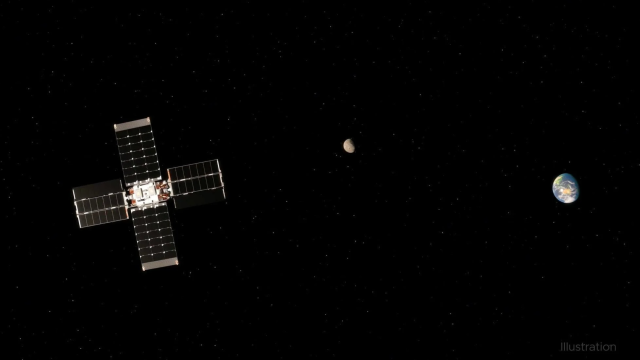After NASA’s Moon-faring, water-hunting probe faced an untimely demise before it was ever able to reach its final destination, mission scientists have officially declared that clogged propellant lines led to the mission’s failure.
SpaceNews reports that Celeste Smith and Nathan Cheek of NASA’s Jet Propulsion Laboratory announced the finding during a presentation at the 37th Annual Small Satellite Conference earlier this week. Lunar Flashlight first began facing issues with blockages in three of of the four lines that provide propellant to its thrusters just three days after it launched in December 2022. The pair said that the blockages were likely caused by titanium particles that became loose as the spacecraft vibrated before and during launch, and that these thruster issues ultimately led to the death of the mission.
While Lunar Flashlight had its fair share of trouble, JPL and project collaborators at Georgia Tech were never ready to immediately give up on the probe. After the team began detecting trouble with Lunar Flashlight’s propellant lines, NASA took a new approach to push the probe into a high Earth orbit instead of the planned near-rectilinear halo orbit. There, Lunar Flashlight would still have a view of the Moon, but only through monthly flybys of the lunar South pole. All the while, NASA continued attempts to clear the propellant lines of debris.
The hits didn’t stop coming, however, as Lunar Flashlight also struggled to get into high Earth orbit with its reduced thrust as the clock ticked ever closer toward its demise. While NASA cooked up a Hail Mary plan to crank up pressure in the obstructed lines above mission standard, Lunar Flashlight ultimately couldn’t complete the maneuvers needed for it to remain in the Earth-Moon system. Unfortunately for the little probe that couldn’t, the space agency declared the mission over in May—just under six months after its launch.
Lunar Flashlight was a briefcase-sized satellite fitted with an instrument called a four-laser reflectometer. With this device, the probe would have used lasers to scan the Moon’s surface in near-infrared wavelength in an attempt to find water ice hidden in the Moon’s permanently shadowed regions. Infrared wavelengths are absorbed by water, so data collected by Lunar Flashlight would be able to delineate water ice from lunar rocks and soil.
The method would’ve allowed NASA to not only find the reservoirs of water-ice, but potentially figure out how large they are, since more absorption could indicate more water. While Lunar Flashlight may be dead, these reservoirs could still be a source of drinking water, fuel, or even breathable oxygen for future crewed missions to the Moon.
For more spaceflight in your life, follow us on Twitter and bookmark Gizmodo’s dedicated Spaceflight page.
